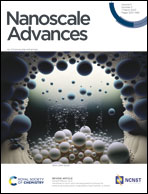Withania somnifera-derived carbon dots protect human epidermal cells against UVB-induced cell death and support growth factor-mediated wound healing†
Abstract
Solar radiation comprising UVA and UVB regions is considered a skin-damaging factor inducing inflammation, oxidative stress, hyperpigmentation, and photo-aging. Photoluminescent carbon dots (CDs) were synthesized from the root extract of a Withania somnifera (L.) Dunal plant and urea, using a one-step microwave method. These Withania somnifera CDs (wsCDs) were 14.4 ± 0.18 d nm in diameter and presented photoluminescence. UV absorbance showed the presence of π–π* (C![[double bond, length as m-dash]](https://www.rsc.org/images/entities/char_e001.gif) C) and n–π* (C
C) and n–π* (C![[double bond, length as m-dash]](https://www.rsc.org/images/entities/char_e001.gif) O) transition regions in wsCDs. FTIR analysis indicated the presence of nitrogen and carboxylic functional groups on the surface of wsCDs. HPLC analysis of wsCDs showed the presence of withanoside IV, withanoside V, and withanolide A. The wsCDs were found to be biocompatible in human skin epidermal (A431) cells and hindered UVB irradiation-induced loss of metabolic activity and oxidative stress. The wsCDs supported rapid dermal wound healing through augmented TGF-β1 and EGF gene expression levels in A431 cells. Finally, wsCDs were found to be biodegradable through a myeloperoxidase-catalyzed peroxidation reaction. The study concluded that under in vitro conditions, Withania somnifera root extract-derived biocompatible carbon dots provided photo-protection against UVB-stimulated epidermal cell damage and supported rapid wound healing.
O) transition regions in wsCDs. FTIR analysis indicated the presence of nitrogen and carboxylic functional groups on the surface of wsCDs. HPLC analysis of wsCDs showed the presence of withanoside IV, withanoside V, and withanolide A. The wsCDs were found to be biocompatible in human skin epidermal (A431) cells and hindered UVB irradiation-induced loss of metabolic activity and oxidative stress. The wsCDs supported rapid dermal wound healing through augmented TGF-β1 and EGF gene expression levels in A431 cells. Finally, wsCDs were found to be biodegradable through a myeloperoxidase-catalyzed peroxidation reaction. The study concluded that under in vitro conditions, Withania somnifera root extract-derived biocompatible carbon dots provided photo-protection against UVB-stimulated epidermal cell damage and supported rapid wound healing.

- This article is part of the themed collection: Celebrating nanoscience in India


 Please wait while we load your content...
Please wait while we load your content...